The best fidgets for kids to help with anxiety, focus, attention, and calming down. Learn why fidgets for kids work, when they don’t, and who they’re for.
I was hoping this day would be different, but deep down, I knew it was coming. How could I not, nearly everyday in my son’s last year of preschool he had cried and even clawed at me in desperation as it was time to go into his classroom. We continued to persevere through these difficult drop-offs because he always had a wonderful time once I was outside of the building.
Even knowing this, I couldn’t shake the feeling that there was more I could be doing for him. It hurt my heart to see that panicked look in his eyes and feel his hands grasping for me as his teacher guided him away.
While we tried a lot of strategies for his separation anxiety, there was one that helped more than anything: a fidget toy.
I wish I could say that my OT-brain thought of this immediately, but the truth is, it was my son’s idea. I finally asked him what he thought would help him go into the classroom without being upset, and he thought for a few seconds before looking at me right in the eyes and saying, “Maybe some kind of ball that I could keep in my pocket and squish?”
Stunned at his ability at the age of 5 to specifically identify a sensory strategy that would help, I happily said, “Yes, I think that would be perfect. I think we can make one together.”
Since my son has some sensory needs, this wasn’t a total surprise, but it was a fantastic idea and you know what, it worked! In this situation, a fidget was used to help anxious and panicky feelings, but they’re super effective for several other challenges kids often face as well.
I’ll walk you through what those are, as well as some of the most common fidgets for kids, my favorites as a therapist, and even a DIY fidget toy that I made with my son.
What is a Fidget Toy?
Just to be clear, what we’re talking about here is any sort of toy or object that fits inside of your child’s hand and that they can manipulate. There are literally hundreds of different types available, but truly anything your child can literally move in their hands is in fact a fidget toy. Some examples are paperclips, tags, small stuffed animals, rubix cubes, stress balls, fidget spinners, etc.
Who are Fidget Toys for?
You already know that fidgets can be used as a tool to help kids with anxiety, but the most common reason they are used is for attention or difficulty sitting still. Usually for kids that love to be in motion, constantly on the go.
That fidget toy that they can keep on their lap while sitting at a desk in a classroom, listening to a book during story time at the library, or while waiting for the rest of the family to finish their dinner, can provide them enough movement that they stay where they’re supposed to without getting up 100 times.
For other kids, fidgets may help them focus better. Instead of daydreaming while their teacher is explaining a new concept, the little movements they get from the fidget help them stay focused on the task at hand.
Since kids with ADHD, Autism, and various other developmental diagnoses often have difficulty with sitting still, focusing, and anxiety, it’s common for them to use fidget toys in some fashion. But, fidgets can be used for any child that doesn’t have a diagnosis, but is challenged in any of these areas. The good news is that with the popularity of fidget spinners and an increasing knowledge of sensory needs in kids, more people are aware that fidgets can be used as a tool to help kids.
Some other ways fidgets can be used for kids are:
- To relax: think about before bed or in a sensory tent
- To provide visual stimulation: Fidget spinners and light up spinners can give this sensory input if your child is seeking it
- To give tactile input: perfect for kids who love to touch EVERYTHING, in some environments, this isn’t appropriate, but a fidget toy can help them meet that need
- To provide proprioceptive input: kids that love to squeeze, push, and climb may seek out that type of deep pressure input and some types of fidgets can give it to them when they have to participate in more sedentary activities
Why do Fidgets for Kids Work?
To say this simply, fidgets work for some kids because of the sensory input they provide. A fidget may be giving sensory information to the brain that helps your child calm down or it’s giving their brain a sensation they need more of. This is important because it helps balance out or regulate the sensory system. And, when that happens, it frees up brain space and allows them to focus, listen, or do whatever else is being asked of them.
This is the crux of another powerful sensory tool called the sensory diet. Head over to What is a Sensory Diet to learn more.
When Can Fidgets for Kids Do More Harm Than Good?
The problem is that sometimes fidgets can sometimes do more harm than good. In some cases, fidgets can be more distracting to the child or other children around them. Some teachers have banned fidget spinners from their class because so many kids were using them and the opposite effect was happening: less attention and focus.
When using any sensory tool or toy, it’s always helpful to take a step back and think through if it’s actually benefiting the child or not. Sensory toys can be incredibly useful, but not for every kid, in every situation.
Which is why it’s helpful to spend some time thinking through what your child’s sensory needs are. I walk you through some steps to discovering this in the Sensory Diet Template post, if you need more help.
Which Fidget is Best for Your Kid?
I like to first start off by showing kids options of fidget toys, even if it’s online photos. As was the case with my son, they will often gravitate towards something that will meet their sensory needs. But, if your child is very young or non-verbal, you can make some educated guesses by thinking about two things:
- What is the goal of the fidget?
- What types of sensory input does my child seek out or helps calm them?
Let’s talk about #1. If you’re looking for a fidget toy to help calm and relax at home or in the car, it doesn’t matter if the fidget is noisy or has bright light, as some do. But, if you’re going to be using a fidget to help with improved attention, you’re going to want one that can be used discreetly either in their pocket, their lap, or perhaps on top of their desk.
And, if you’re child hates bright lights and visual stimulation, you’re probably going to want to avoid one’s that offer that. Or, if your child loves to squeeze and is looking for deep pressure or proprioceptive input, a fidget spinner isn’t going to provide that, but a stress ball will.
If you aren’t sure what each type of fidgets provide certain types of sensory input, I’ll walk you through all of that below.
How to Use a Fidget for Kids
Once you’ve narrowed down one or a few options, simply have them available to your child. Again, if it’s a setting where you’re trying to improve sitting still, focus, or anxiety in a public setting, you’ll want to decide if it needs to be kept in their pocket, lap, or some other designated area. Teach, practice, and clearly re-iterate any rules.
For instance, when my son used his fidget at preschool, I was aware his teacher was fairly strict and very “old-school”. We talked a lot about keeping his fidget inside his pocket and putting his hand inside to squeeze it whenever he needed it. I made it very clear that if he pulled it out, it would likely be taken away. I gave him reminders of this.
Fortunately, in my case, the teacher did notice him using it, but saw it wasn’t a distraction or nuisance to the classroom and supported it. If you need help setting up a school environment with your child’s teacher, check out Sensory Strategies for the Classroom.
If you’re using your fidget as part of a calm-down time at home, simply have the fidget available for them. Sometimes it’s helpful to have several different fidgets to choose from.
Affiliate links used below. See our full disclosure.
Fidgets that Could Help Your Child
I’m going to provide a selection of different fidgets of kids. I couldn’t possibly cover them all, but these are some of my favorites and some of the most common. Keep in mind that having a couple of different fidgets available can be helpful. Sometimes having them in a basket, bin, or stashed in a special pouch of their bookbag can be helpful. If you do plan on sending these to school, make sure you have that convo with your child’s teacher first.
1. Stress Ball: Gives proprioceptive and tactile input. These can easily be put inside a pocket, and can made in just minutes. This is a DIY stress ball tutorial. Consider trying different textures inside because they all give slightly different types of input.
This is the fidget my son used, we put flour inside of ours. On the outside of the balloon I wrote I love you in a Sharpie, this was a very important part for him. He carried this one with him everyday before deciding he didn’t need it anymore in kindergarten!
2. Fidget Spinner: Arguably the most popular fidget ever. While the trend is certainly fun, it does provide mostly visual input. I’d only recommend this if your child enjoys staring at moving or bright objects, and check with teachers before sending to school because this can cause more distraction than focus in most cases. Great for calming down at home though!
3. Putty: OT’s often use putty to strengthen fine motor skills, but it can also make an excellent fidget. However, it’s not the kind of thing you want to give your child while they’re in bed or on the couch. This is definitely a table top activity.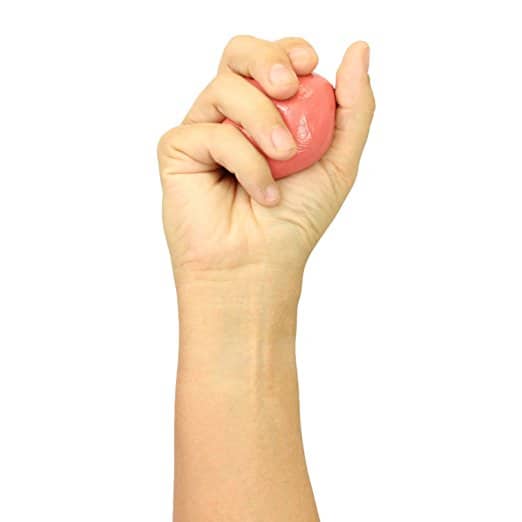
4. Koosh Ball: Perfect for kids who love tactile input, the classic koosh ball has lots of feels, doesn’t make any noise, and can easily be stashed in a pocket if need be. For some kids, this won’t give enough sensory input though. 5. Tangle: This fidget can be be pushed and pulled as it seems to always be moving in a new way. It can also add a little visual stimulation as you watch it twist in new directions, but it’s not a huge distraction.
5. Tangle: This fidget can be be pushed and pulled as it seems to always be moving in a new way. It can also add a little visual stimulation as you watch it twist in new directions, but it’s not a huge distraction.
6. Fidget Cube: Some kids love to push buttons or click a pen when they have to sit still, if that’s your kid, the fidget cube may be the perfect fidget! Some cubes make a small clicking sound though which can be distracting, or annoying, in some environments like a classroom.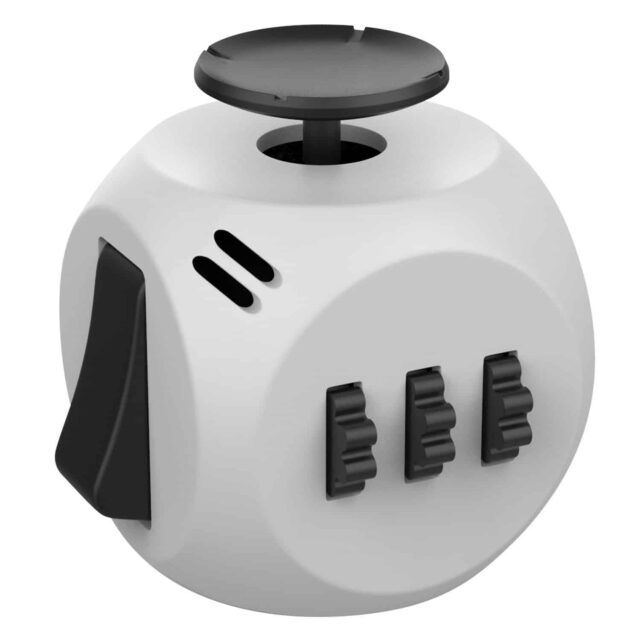
7. Squeeze a Bean Keychain: I love this fidget because it looks like a regular ol’ keychain. You can hook it onto a book bag or belt loop and squeeze any of the beans to make them pop out. This fidget also gives that proprioceptive input that many kids seek and that calms in general.
8. Liquid Motion Bottle: Huge visual component for kids as they can endlessly watch the circles drop and take new shapes. I’d suggest this for use when independently trying to calm or relax. It may be distracting for some kids if they’re using it when they need to be paying attention to something else.
9. Stretch Fidgets: These stick shaped, non-messy, and easy to conceal fidgets can be pulled and twisted around fingers. Again, a low-distraction option.
10. Hedgehog Rings: Loads of tactile input with these spiky rings that can be squished and even worn on a wrist. These fidgets are also BPA free and can be easily cleaned in the dishwasher, bonus!
11. Squishy Animal: Works in the same way as a stress ball, but may be more motivating for kids that like animals or the cute-effect these little guys have.
Take a few minutes to consider if fidgets are a sensory tool that could work for your kid, and which you’d like to try first. Are you the DIY type or do you want to pick up a couple of options to have on hand (okay, that was a bad pun!)?
Don’t forget about asking your child which they’d think would be the most helpful, like my son, they might just surprise you with an intuitive answer that is perfect for them.
If you’re new here, grab the 21 Sensory Red Flags Printable that I’ll send right to your inbox. It’s an awesome checklist if you’re wondering about your child’s sensory “issues” or needs! You’ll find some other free resources inside too.
More Sensory Tools for Kids
How and When to Use a Weighted Lap Pad for Concentration and Calming
Did You Say Wobble Cushion? What it is and How it Works
The Must-Read Weighted Blanket Guide for Kids: Calm, Relax, Sleep
60 Printable Sensory Diet Cards for Kids to Thrive
Did You Pin This?
Save this one so you can find it again in a pinch!
Alisha Grogan is a licensed occupational therapist and founder of Your Kid’s Table. She has over 14 years experience with expertise in sensory processing and feeding development in babies, toddlers, and children. Alisha also has 3 boys of her own at home. Learn more about her here.
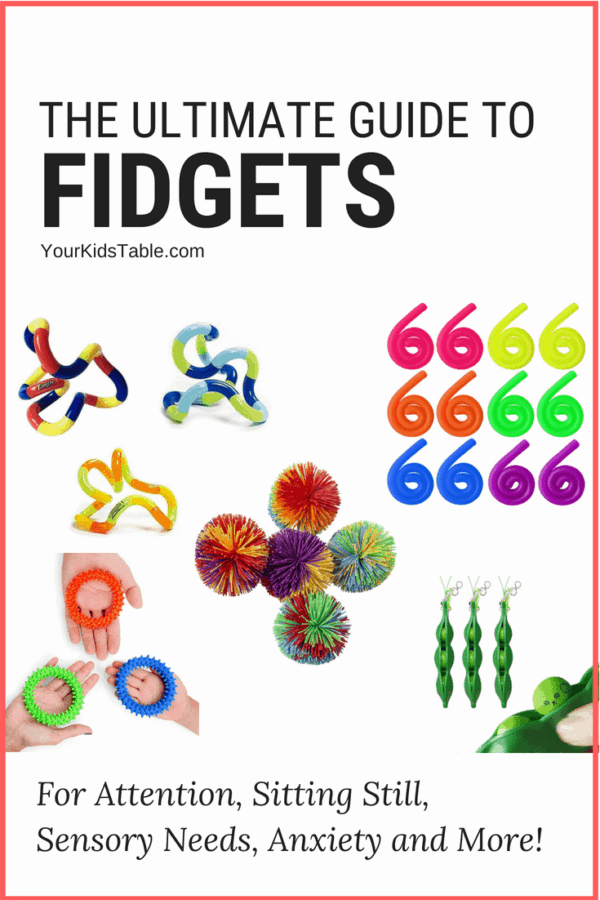



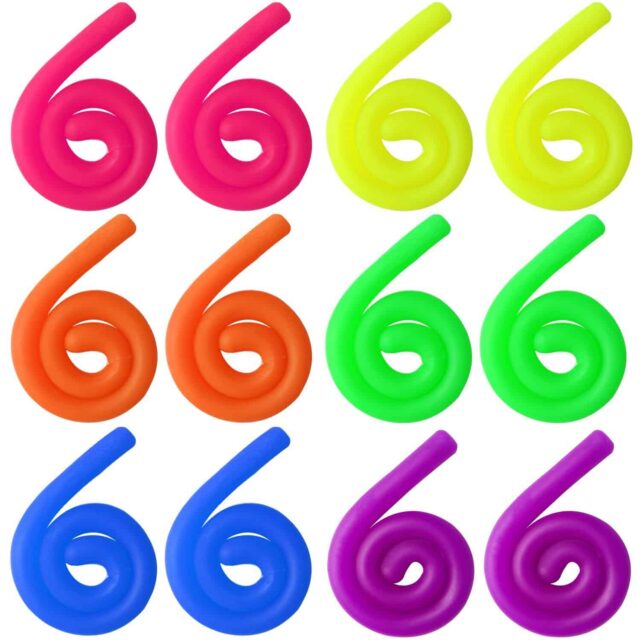

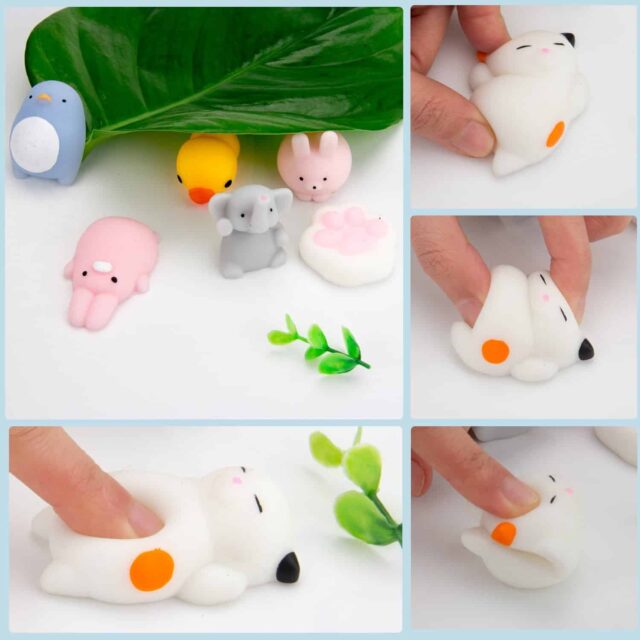
Thank you for sharing the informative article.
Thanks for reading!
Laura
Your Kid’s Table team member
Yes, I most definitely and absolutely do recommend pop-its as somebody with ADHD, who just happens to know some people with ADHD, ASD, and OCD. Oh, by the way, ADHD stands for Attention-Deficit Hyperactivity Disorder, ASD stands for Autism Spectrum Disorder, and OCD stands for Obsessive-Compulsive Disorder. I have ADHD, myself. Anyways, you’re welcome. Peace out. Have fun. Bye. Goodbye. Have fun. Enjoy yourself. Bye. Goodbye.
Are fidget poppers a good tool? My daughter (2 years) was introduced to them by a friend and really likes it. I don’t see them mentioned on your list.
Hey Susanna,
Fidget poppers can be a good tool for some kiddos! For other kiddos they seem to be a little too distracting and don’t really help with focus, in school for example. It depends on the purpose you’re using them for and how your child responds to them 🙂
Best,
Andrea
My Mom hates fidgets, its really annoying. she said she will never by them. They are really nice.
Hi Matthew,
We’re so glad you found our website! Feel free to share our article with your mom 🙂
Best,
Andrea
My mom doesn’t really like them either!
In fact at the beginning she wanted me to”STOP”buying them…which I can’t imagine”WHY”because i”AM”AUTISTIC and she KNOWS that perfectly well!
I think shes gotten used to them now though because when I asked if she could get me a few more for Christmas that I heard were”only”selling those particular ones”ONLINE ONLY”she was all open to it!
Very good content.